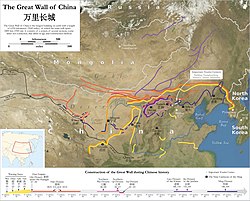
Back Groot Muur van China Afrikaans Chinesische Mauer ALS የቻይና ታላቅ ግድግዳ Amharic Gran Muralla Chinesa AN سور الصين العظيم Arabic السور العظيم ديال الشينوا ARY سور الصين العظيم ARZ চীনৰ মহাপ্ৰাচীৰ Assamese Gran Muralla China AST Böyük Çin səddi Azerbaijani
| Great Wall of China | |
|---|---|
萬里長城 / 万里长城 | |
 The Ming dynasty Great Wall at Jinshanling | |
 Map of all the wall constructions | |
| General information | |
| Type | Fortification |
| Country | China |
| Coordinates | 40°41′N 117°14′E / 40.68°N 117.23°E |
| Official name | The Great Wall |
| Location | Asia-Pacific |
| Criteria | Cultural: i, ii, iii, iv, vi |
| Reference | 438 |
| Inscription | 1987 (11th Session) |
| Area | 2,151.55 ha |
| Buffer zone | 4,800.8 ha |
| Technical details | |
| Size | 21,196.18 km (13,170.70 mi)[1][2][3] |
| Great Wall of China | |||||||||||||||||||||||||||||
|---|---|---|---|---|---|---|---|---|---|---|---|---|---|---|---|---|---|---|---|---|---|---|---|---|---|---|---|---|---|
| Traditional Chinese | 長城 | ||||||||||||||||||||||||||||
| Simplified Chinese | 长城 | ||||||||||||||||||||||||||||
| Literal meaning | "The Long Wall" | ||||||||||||||||||||||||||||
| |||||||||||||||||||||||||||||
| Alternative Chinese name | |||||||||||||||||||||||||||||
| Traditional Chinese | 萬里長城 | ||||||||||||||||||||||||||||
| Simplified Chinese | 万里长城 | ||||||||||||||||||||||||||||
| Literal meaning | "The 10,000-li Long Wall" | ||||||||||||||||||||||||||||
| |||||||||||||||||||||||||||||
The Great Wall of China (traditional Chinese: 萬里長城; simplified Chinese: 万里长城; pinyin: Wànlǐ Chángchéng, literally "ten thousand li long wall") is a series of fortifications that were built across the historical northern borders of ancient Chinese states and Imperial China as protection against various nomadic groups from the Eurasian Steppe. Several walls were built from as early as the 7th century BC,[4] with selective stretches later joined by Qin Shi Huang (220–206 BC), the first emperor of China. Little of the Qin wall remains.[5] Later on, many successive dynasties built and maintained multiple stretches of border walls. The best-known sections of the wall were built by the Ming dynasty (1368–1644).
Apart from defense, other purposes of the Great Wall have included border controls, allowing the imposition of duties on goods transported along the Silk Road, regulation or encouragement of trade and the control of immigration and emigration.[6] Furthermore, the defensive characteristics of the Great Wall were enhanced by the construction of watchtowers, troop barracks, garrison stations, signaling capabilities through the means of smoke or fire, and the fact that the path of the Great Wall also served as a transportation corridor.
The frontier walls built by different dynasties have multiple courses. Collectively, they stretch from Liaodong in the east to Lop Lake in the west, from the present-day Sino–Russian border in the north to Tao River (Taohe) in the south; along an arc that roughly delineates the edge of the Mongolian steppe; spanning 21,196.18 km (13,170.70 mi) in total.[7][3] Today, the defensive system of the Great Wall is generally recognized as one of the most impressive architectural feats in history.[8]
- ^ "China's Great Wall Found To Measure More Than 20,000 Kilometers". Bloomberg. June 5, 2012. Retrieved June 6, 2012.
- ^ "China's Great Wall is 'longer than previously thought'". BBC News. June 6, 2012. Archived from the original on December 5, 2021. Retrieved December 28, 2021.
- ^ a b Cite error: The named reference
nchawas invoked but never defined (see the help page). - ^ The New York Times with introduction by Sam Tanenhaus (2011). The New York Times Guide to Essential Knowledge: A Desk Reference for the Curious Mind. St. Martin's Press of Macmillan Publishers. p. 1131. ISBN 978-0-312-64302-7.
Beginning as separate sections of fortification around the 7th century B.C.E and unified during the Qin Dynasty in the 3rd century B.C.E, this wall, built of earth and rubble with a facing of brick or stone, runs from east to west across China for over 4,000 miles.
- ^ "Great Wall of China". Encyclopædia Britannica. October 21, 2023.
Large parts of the fortification system date from the 7th through the 4th century BC. In the 3rd century BC Shihuangdi (Qin Shi Huang), the first emperor of a united China (under the Qin dynasty), connected a number of existing defensive walls into a single system. Traditionally, the eastern terminus of the wall was considered to be Shanhai Pass (Shanhaiguan) on the coast of the Bohai (Gulf of Zhili), and the wall's length – without its branches and other secondary sections – was thought to extend for some 6,690 km (4,160 mi).
- ^ Shelach-Lavi, Gideon; Wachtel, Ido; Golan, Dan; Batzorig, Otgonjargal; Amartuvshin, Chunag; Ellenblum, Ronnie; Honeychurch, William (June 2020). "Medieval long-wall construction on the Mongolian Steppe during the eleventh to thirteenth centuries AD". Antiquity. 94 (375): 724–741. doi:10.15184/aqy.2020.51. ISSN 0003-598X.
- ^ "Great Wall of China even longer than previously thought". Canadian Broadcasting Corporation. June 6, 2012. Retrieved June 6, 2012.
- ^ "Great Wall of China". History. April 20, 2009.